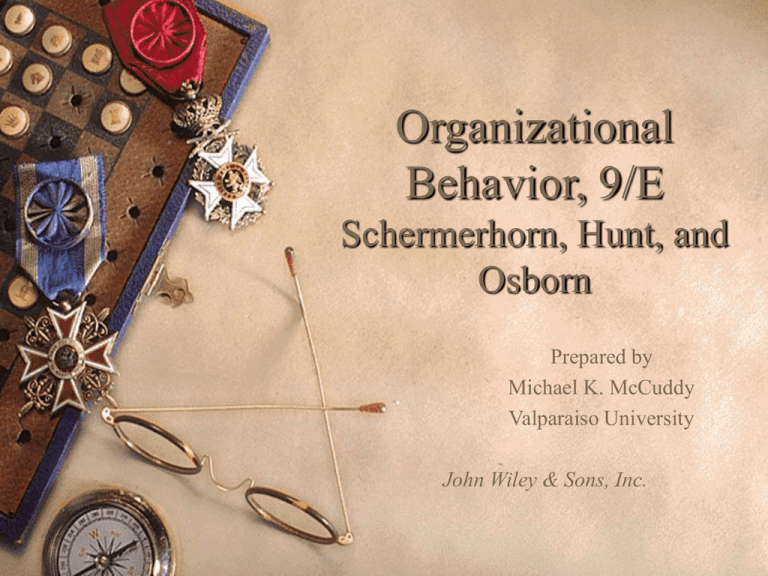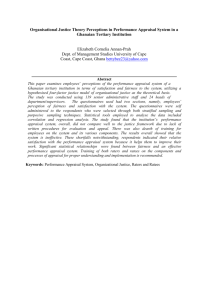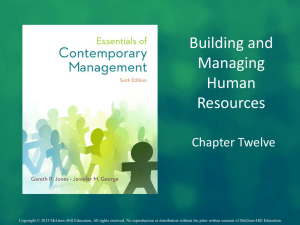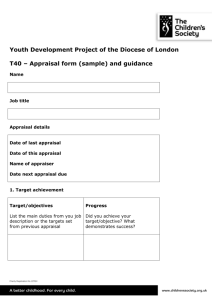
Organizational
Behavior, 9/E
Schermerhorn, Hunt, and
Osborn
Prepared by
Michael K. McCuddy
Valparaiso University
John Wiley & Sons, Inc.
Chapter 8 Study Questions
What is goal setting?
What is performance appraisal?
What are compensation and rewards?
What are human resource
development and person-job fit?
Organizational Behavior: Chapter 8
2
Study Question 1: What is goal setting?
Organizational Behavior: Chapter 8
3
Study Question 1: What is goal setting?
Goal setting guidelines.
– Difficult goals are more likely to lead to
higher performance than are less difficult ones.
– Specific goals are more likely to lead to higher
performance than are no goals or vague or
general ones.
– Task feedback, or knowledge of results, is
likely to motivate people toward higher
performance by encouraging the setting of
higher performance goals.
Organizational Behavior: Chapter 8
4
Study Question 1: What is goal setting?
Goal setting guidelines (cont.).
– Goals are most likely to lead to higher
performance when the people have the
abilities and the feeling of self-efficacy
required to accomplish them.
– Goals are most likely to motivate people
toward higher performance when they are
accepted and there is commitment to them.
Organizational Behavior: Chapter 8
5
Study Question 1: What is goal setting?
Goal setting and MBO.
– Management by objectives (MBO) is a process
of joint goal setting between a supervisor and
a subordinate.
– MBO is consistent with the goal setting
guidelines derived from the Locke and Latham
model.
– MBO establishes performance goals consistent
with higher level work unit and organizational
objectives.
Organizational Behavior: Chapter 8
6
Study Question 1: What is goal setting?
Organizational Behavior: Chapter 8
7
Study Question 1: What is goal setting?
Potential problems with MBO.
– Too much paperwork. in documenting goals and
accomplishments.
– Too much emphasis on:
• Goal-oriented rewards and punishments.
• Top-down goals.
• Goals that are easily stated in objective terms.
• Individual goals instead of group goals.
– MBO may need to be implemented organization-wide.
Organizational Behavior: Chapter 8
8
Study Question 2: What is performance
appraisal?
Performance appraisal.
– Helps both the manager and subordinate
maintain the organization-job-employee
characteristics match
– The process of systematically evaluating
performance and providing feedback upon
which performance adjustments can be made.
Organizational Behavior: Chapter 8
9
Study Question 2: What is performance
appraisal?
Functions of performance appraisal.
– Define the specific job criteria against which
performance will be measured.
– Measure past job performance accurately.
– Justify rewards, thereby differentiating
between high and low performance.
– Define ratee’s needed development
experiences.
Organizational Behavior: Chapter 8
10
Study Question 2: What is performance
appraisal?
Two general purposes of good performance
appraisal.
– Evaluation.
• Concerned with such issues as promotions,
transfers, terminations, and salary increases.
– Feedback and development.
• Let workers know their status relative to firm’s
expectations and performance objectives.
Organizational Behavior: Chapter 8
11
Study Question 2: What is performance
appraisal?
Who does the performance appraisal?
– Traditionally done by ratee’s immediate
superior.
– People other than immediate superior may
have better information on certain aspects of
ratee’s performance.
– 360-degree evaluation provides appraisal
information from multiple perspectives.
Organizational Behavior: Chapter 8
12
Study Question 2: What is performance
appraisal?
Performance appraisal dimensions and
standards.
– Output measures.
• Quantity of work output.
• Quality of work output.
– Activity measures.
• Behavioral measures that are typically obtained
from the evaluator’s observation and rating.
Organizational Behavior: Chapter 8
13
Study Question 2: What is performance
appraisal?
Comparative methods of performance
appraisal.
– Ranking.
• Raters rank order people from best to worst.
– Paired comparisons.
• Raters compare each person with every other
person.
– Forced distribution.
• Raters place a specific proportion of employees
into each performance category.
Organizational Behavior: Chapter 8
14
Study Question 2: What is performance
appraisal?
Absolute methods of performance appraisal.
– Graphic rating scales.
• Raters assign scores on a list of dimensions related
to high performance outcomes in a given job.
– Critical incident diary records.
• Rater records incidents of unusual success or
failure in a given performance aspect.
– Behaviorally anchored rating scales (BARS).
• Rater identifies observable job behaviors.
Organizational Behavior: Chapter 8
15
Study Question 2: What is performance
appraisal?
Absolute methods of performance appraisal
(cont.).
– Behavioral observation scale (BOS).
• Rater rates each observable job behavior on a five-
point frequency scale.
– Management by objectives.
• Jointly established goals used as standards against
which the subordinate’s performance is evaluated.
Organizational Behavior: Chapter 8
16
Study Question 2: What is performance
appraisal?
To be meaningful, an appraisal system must be:
– Reliable — provide consistent results across time.
– Valid — actually measure people on relevant job
content.
Measurement errors can threaten the reliability or
validity of performance appraisals.
Organizational Behavior: Chapter 8
17
Study Question 2: What is performance
appraisal?
Measurement errors in performance appraisal.
– Halo errors.
• Raters evaluate on several different dimensions and
give a similar rating for each dimension.
– Leniency errors.
• Raters tend to give everyone relatively high
ratings.
– Strictness errors.
• Raters tend to give everyone relatively low ratings.
Organizational Behavior: Chapter 8
18
Study Question 2: What is performance
appraisal?
Measurement errors in performance appraisal
(cont.).
– Central tendency errors.
• Raters lump everyone together around the average
or middle.
– Low differentiation errors.
• Raters restrict themselves to a small part of the
rating scale.
• Examples include leniency, strictness, and central
tendency errors.
Organizational Behavior: Chapter 8
19
Study Question 2: What is performance
appraisal?
Measurement errors in performance appraisal
(cont.).
– Recency errors.
• Raters allow recent events to exercise undue
influence on ratings.
– Personal bias errors.
• Raters let personal biases, such as stereotypes,
unduly influence the ratings.
– Cultural bias errors.
• Raters allow cultural differences of employees to
influence the performance appraisal.
Organizational Behavior: Chapter 8
20
Study Question 2: What is performance
appraisal?
Ways to reduce rating errors in performance
appraisals.
– Training raters to understand the evaluation process
–
–
–
–
and recognize errors.
Ensuring that raters observe ratees on an ongoing
basis.
Not having the rater evaluate too many ratees.
Ensuring the clarity and adequacy of performance
dimensions and standards.
Avoiding terms that have different meanings for
different raters.
Organizational Behavior: Chapter 8
21
Study Question 2: What is performance
appraisal?
Guidelines for ensuring the legality of
performance appraisal systems.
– Base appraisal on job requirements as
reflected in performance standards.
– Ensure that employees clearly understand the
performance standards.
– Use clearly defined dimensions.
– Use behaviorally-based dimensions supported
by observable evidence.
Organizational Behavior: Chapter 8
22
Study Question 2: What is performance
appraisal?
Guidelines for ensuring the legality of
performance appraisal systems (cont.).
– Avoid abstract trait names.
– Ensure that scale anchors are brief and
logically consistent.
– Ensure that the system is valid and
psychometrically sound.
– Provide an appeal mechanism to handle
appraisal disagreements.
Organizational Behavior: Chapter 8
23
Study Question 3: What are
compensation and rewards?
Pay as an extrinsic reward.
– Pay can help organizations attract and retain
highly capable workers, and help satisfy and
motivate these workers.
– High levels of job performance must be
viewed as the path through which high pay can
be achieved.
– Merit pay bases an individual’s salary or wage
increase on the person’s performance.
Organizational Behavior: Chapter 8
24
Study Question 3: What are
compensation and rewards?
Pay as an extrinsic reward (cont.).
– Merit pay should be based on realistic and
accurate measures of individual work
performance.
– Some people argue that merit pay plans ignore
the high degree of task interdependence
among employees.
Organizational Behavior: Chapter 8
25
Study Question 3: What are
compensation and rewards?
Creative pay practices.
– Skill-based pay.
• Rewards people for acquiring and developing jobrelevant skills.
– Gain-sharing plans.
• Give workers an opportunity to share in
productivity gains through increased earnings.
– Profit-sharing plans.
• Reward employees based on the entire
organization’s performance
Organizational Behavior: Chapter 8
26
Study Question 3: What are
compensation and rewards?
Creative pay practices (cont.).
– Employee stock ownership plans (ESOPs).
• Give company stock to employees or allow them to
purchase it at a price below market value
– Lump-sum pay increases.
• Provide wage or salary increase in one or more
lump-sum payments.
– Flexible benefit plans.
• Allow workers to select benefits according to their
individual needs.
Organizational Behavior: Chapter 8
27
Study Question 4: What are human
resource development and person-job fit?
Human resource development (HRD) and
the person-job fit.
– HRD and the person-job fit are key
contributing activities in performance
management and rewards.
– Human resource strategic planning provides
the foundation for HRD and the person-job fit.
– Staffing, training, and career planning and
development are important functions in HRD
and achieving a person-job fit.
Organizational Behavior: Chapter 8
28
Study Question 4: What are human
resource development and person-job fit?
Job analysis.
– The process and procedures used to collect
and classify information about tasks the
organization needs to complete.
– Identifies the worker characteristics needed to
perform the job.
– Forms the basis for a job description and job
specifications.
Organizational Behavior: Chapter 8
29
Study Question 4: What are human
resource development and person-job fit?
Recruitment.
– The process of attracting the best qualified individuals
to apply for a given job.
– Typical recruitment steps.
• Advertisement of a position vacancy.
• Preliminary contact with potential job candidates.
• Preliminary screening to obtain a pool of candidates.
– Recruitment approaches are external or internal.
– Realistic job previews.
Organizational Behavior: Chapter 8
30
Study Question 4: What are human
resource development and person-job fit?
Selection.
– A series of steps from initial applicant
screening to final hiring of the new employee.
– Selection process.
•
•
•
•
•
Completing application materials.
Conducting an interview.
Completing any necessary tests.
Doing a background investigation.
Deciding to hire or not to hire.
Organizational Behavior: Chapter 8
31
Study Question 4: What are human
resource development and person-job fit?
Socialization.
– Process that adapts employees to the
organization’s culture.
– Occurs during and after completion of the
staffing process.
– Phases of socialization.
• Anticipatory socialization.
• Encounter.
• Change and acquisition.
Organizational Behavior: Chapter 8
32
Study Question 4: What are human
resource development and person-job fit?
Training.
– A set of activities that provides the opportunity
to acquire and improve job-related skills.
– Types of training.
• On-the-job training involves job instruction while
performing the job in the actual workplace.
• Off-the-job training commonly involves lectures,
videos, and simulations, and increasingly is done
through e-training.
Organizational Behavior: Chapter 8
33
Study Question 4: What are human
resource development and person-job fit?
Organizational Behavior: Chapter 8
34
Study Question 4: What are human
resource development and person-job fit?
Adult life cycle and career stages.
– The different problems and prospects of the adult life
cycle affect people’s work and careers.
– Career stages reflect the different responsibilities and
achievements associated with people’s working lives.
– Life cycle and career stages.
• Entry and establishment or the provisional
adulthood stage.
• Advancement or the first adulthood stage.
• Maintenance, withdrawal, and retirement or the
second adulthood stage.
.
Organizational Behavior: Chapter 8
35
COPYRIGHT
Copyright 2005 © John Wiley & Sons, Inc. All rights reserved.
Reproduction or translation of this work beyond that permitted in Section
117 of the 1976 United States Copyright Act without the express written
permission of the copyright owner is unlawful. Request for further
information should be addressed to the Permissions Department, John Wiley
& Sons, Inc. The purchaser may make back-up copies for his/her own use
only and not for distribution or resale. The Publisher assumes no
responsibility for errors, omissions, or damages, caused by the use of these
programs or from the use of the information contained herein.
Organizational Behavior: Chapter 8
36







